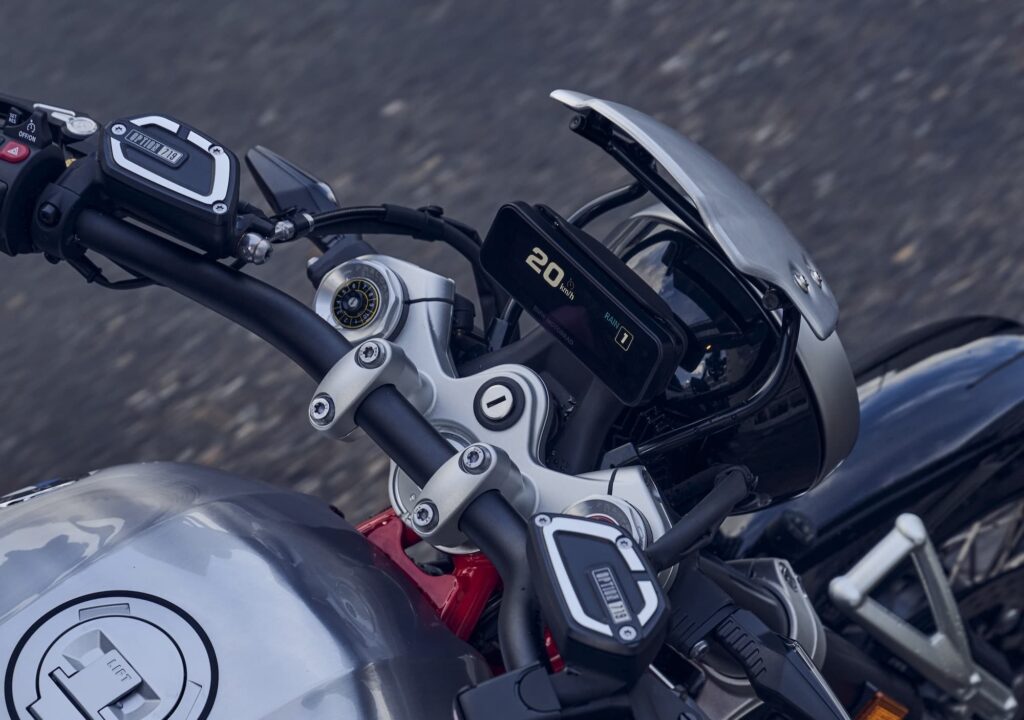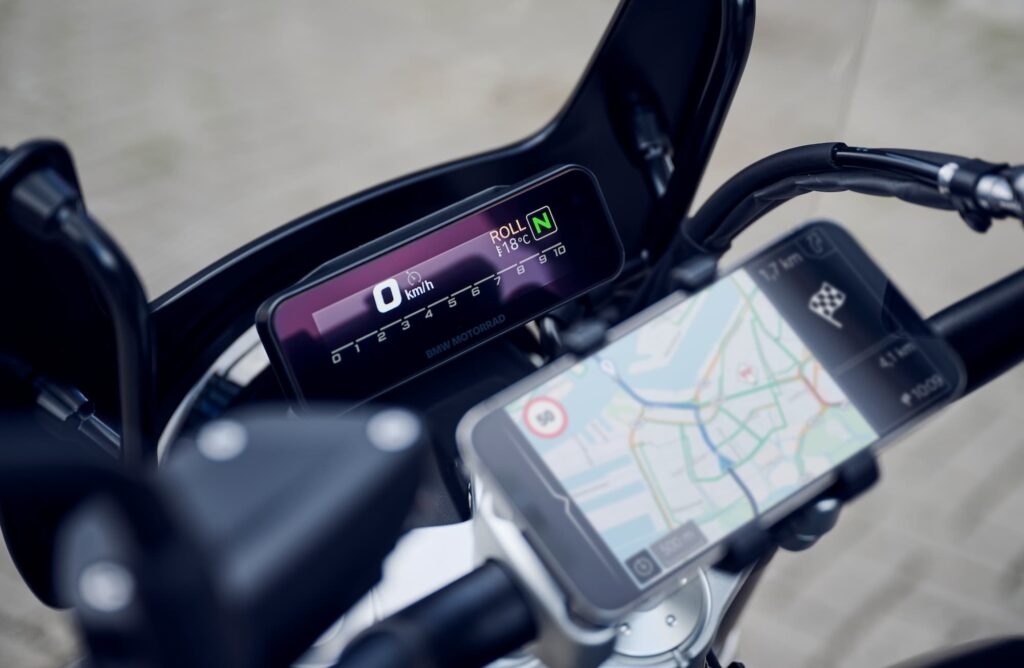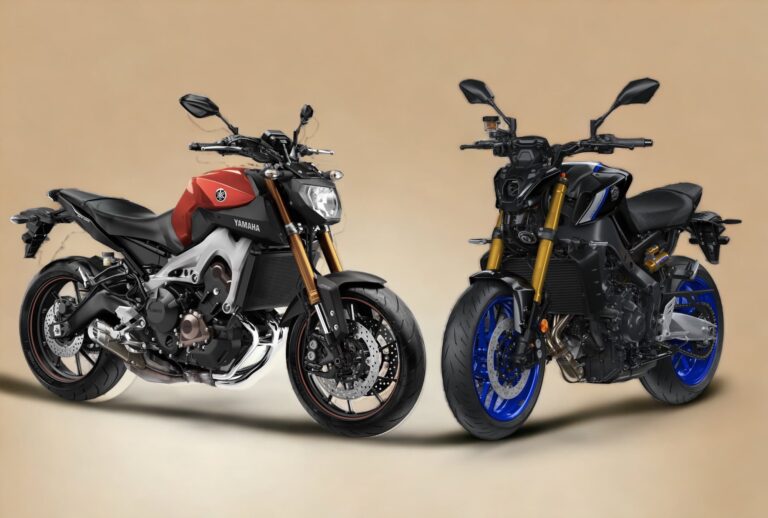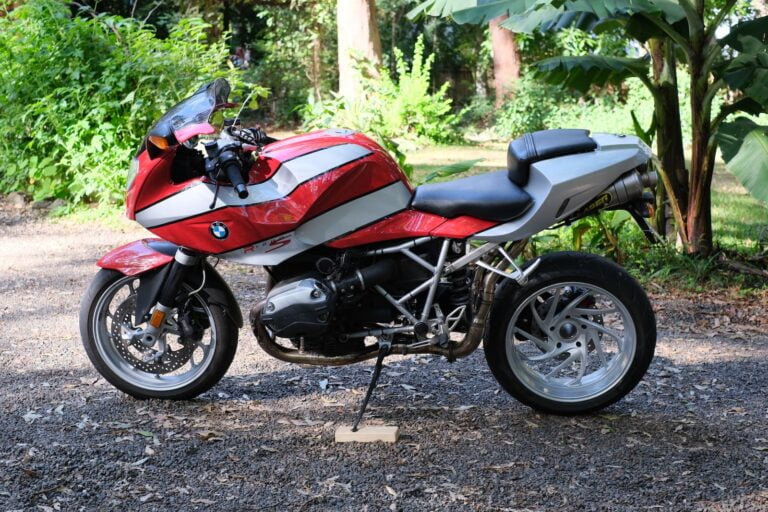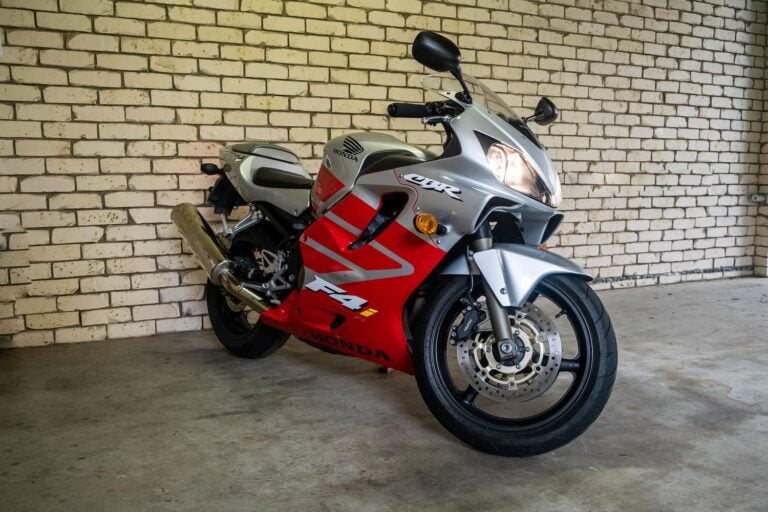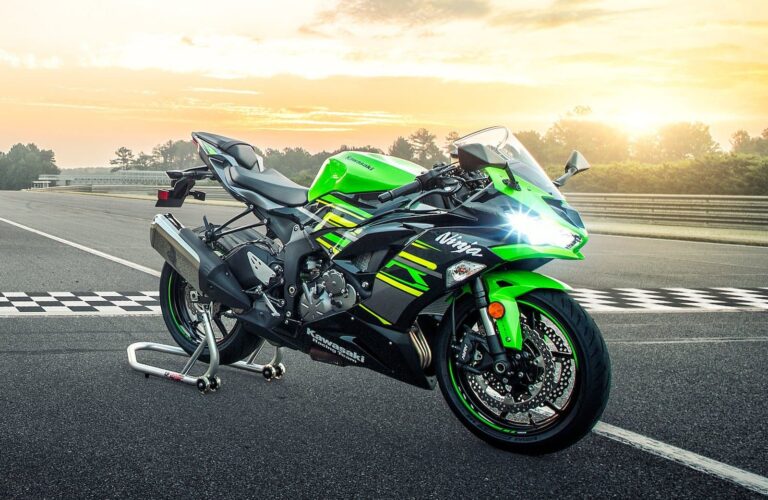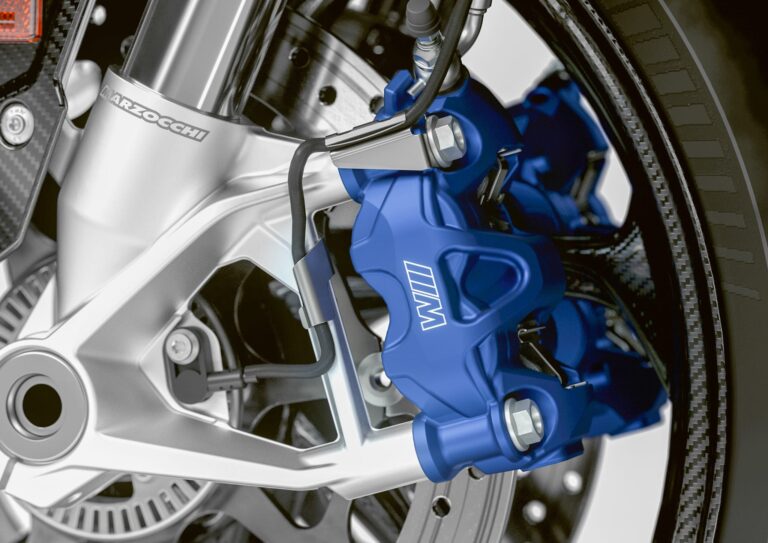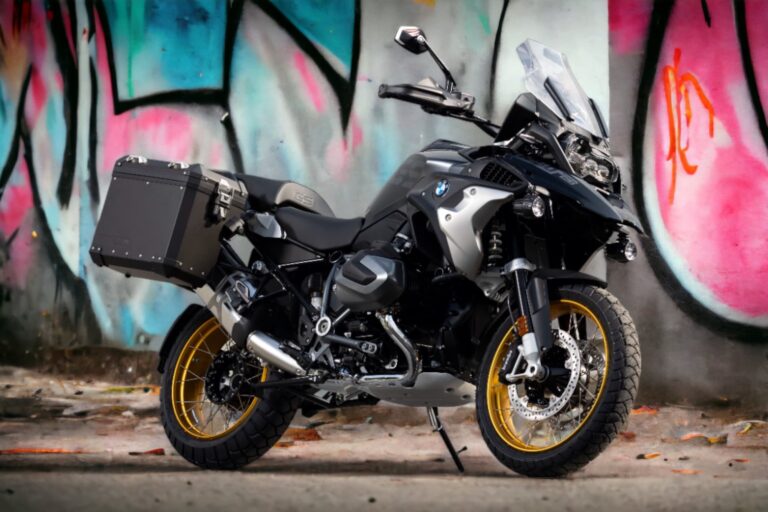BMW announced a new pair of motorcycles based on the venerable 1170 cc air-cooled “twin cam” boxer, the same that powers the BMW R nineT range of motorcycles.
These bikes are called the BMW R 12 and R 12 nineT. I read the announcement and was totally confused. In typical press release fashion, manufacturers announce everything as if it’s new, without really explaining what has changed, what’s really new, and making clear what’s no more.
So I’m answering the questions that plagued me for hours:
- Are the BMW R 12 and R 12 nineT replacing the R nineT?
- What are the differences between them and the R nineT? What do we gain, and what do we lose?
- What are the differences between them?
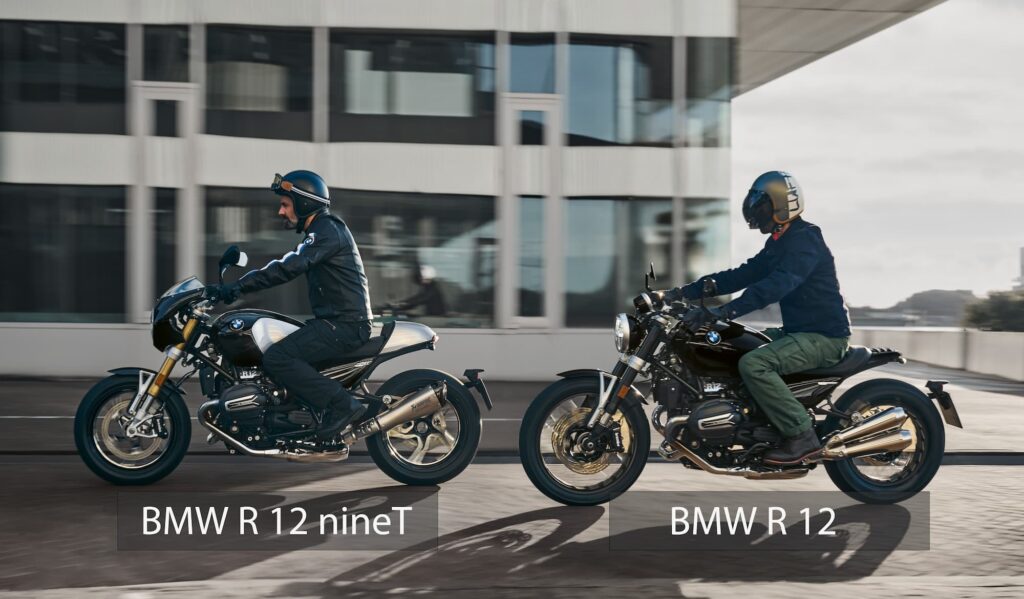
Are you obsessed with motorcycles?
Well, I am. That’s why I created this site — as an outlet. I love learning and sharing what others might find useful. If you like what you read here, and you’re a fraction as obsessed as I am, you might like to know when I’ve published more. (Check the latest for an idea of what you’ll see.)
Brief Background to the BMW R 12 and R 12 nineT
BMW has been making the R nineT line since 2014.
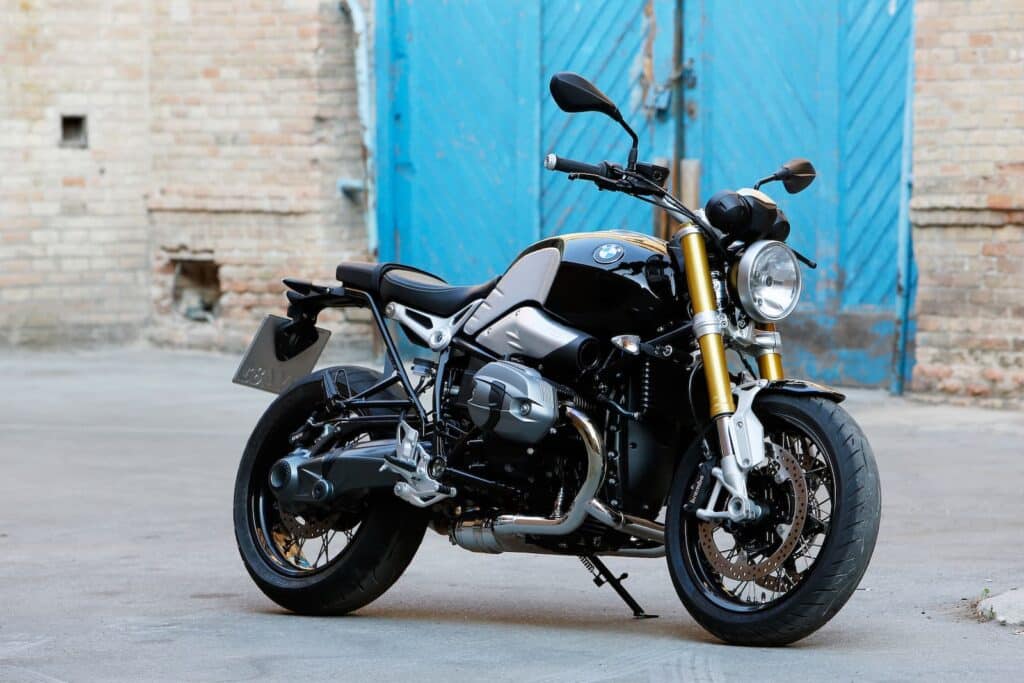
BMW took the air/oil-cooled boxer from the premium R line (in the R 1200 GS, R 1200 RT, etc.), and put it into a retro roadster that focuses on everyday riding fun, rather than being utilitiarian like the GS or RT.
At first, the BMW R nineT looked similar to the R 1200 R, the other naked roadster. But the R carved a different path, opting for high-spec components like a TFT display and migrating to the liquid-cooled engine, whereas the R nineT stuck with its air/oil-cooled boxer.
See the history of BMW engines and how they’ve evolved.
The first-gen R nineT was good, but basic. The front suspension was non-adjustable, something people complained about only because it was a premium bike, not because it was bad.
But over time, BMW dramatically improved the R nineT. The latest generations have every bit of tech you could want in a bike — cornering ABS, cruise control, and of course fully adjustable suspension. They stop short of things like a TFT display, and of course never updated the engine, as the R nineT is supposed to be a retro motorcycle — just with modern safety.
BMW also expanded the R nineT line, adding everything from scrambler-styled bikes to a retro cafe racer (which is the only one they discontinued). As the R nineT got more expensive, BMW also introduced a “Pure” in 2017, which is even more down-spec than the original R nineT, with a non-inverted fork. It’s a very popular model, as it’s a lot cheaper and gives you basically the whole riding experience you could want in a retro roadster.
If you’re interested to see how the R nineT has evolved, check out the R nineT buyer’s guide.
The BMW R nineT is intentionally retro. It’s different from the BMW S 1000 R, which is a high-performance sport bike, even though the R nineT does have some high-spec bits, like an inverted fork (on the premium model) and Brembo brakes.
The ~80 kW / 110 hp engine is lively, but isn’t the kind of engine you rev out. It’s air/oil cooled and enjoys being short shifted. So the R nineT has always been a motorcycle that’s enjoyable at moderate speeds. It has torque everywhere, a comfortable riding position, and enjoys being seen.
Another important predecessor of note to the BMW R 12 in particular is the BMW R 1200 C, BMW’s first attempt at a cruiser.

The BMW R 1200 C was a detuned Oilhead-era engine in a comfortable cruiser format. They’re still well-liked and somewhat rare and unique, especially as they have a Paralever front end, something that BMW decided to forego for the R nineT.
There are a few variants of the BMW R 1200 C, but they’re generally considered a little too sedate for many riders.
See here for the guide to the BMW R 1200 C.
Eventually, BMW discontinued the R 1200 C line, not replacing it with anything until over a decade later, when BMW expanded their “Heritage” line with the R 18.
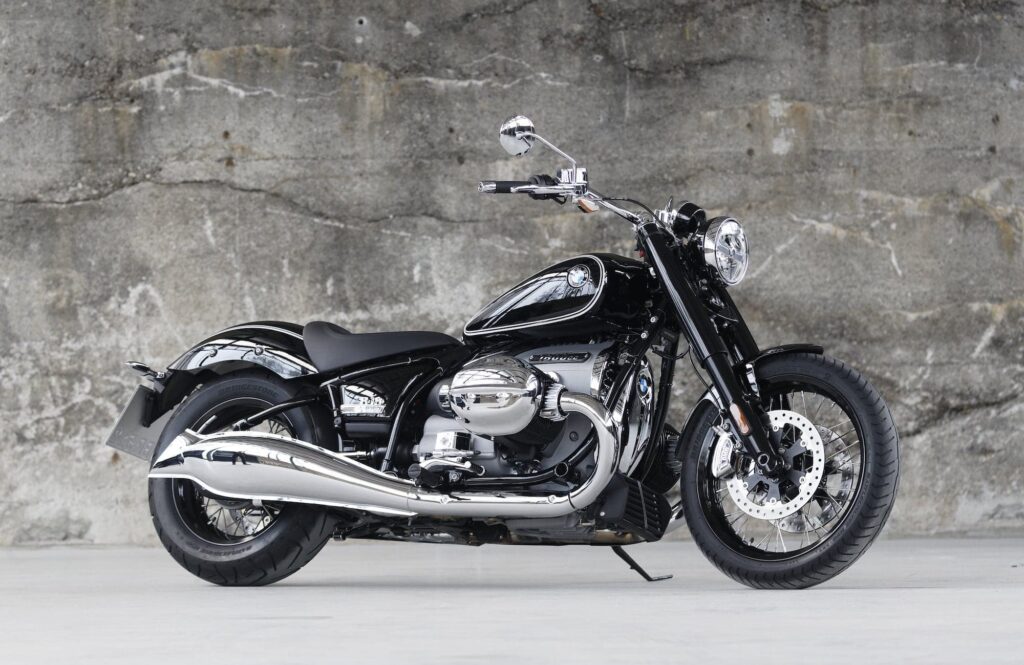
The R 18 is a big cruiser, designed to do cruisers the BMW way and take a small slice out of Harley-Davidson’s unassailable market share in the segment.
The styling of the R 18 is reminiscent of BMW motorcycles from nearly a hundred years ago. It’s remarkably faithful. It’s not for everyone (don’t get into arguments about the exhaust pipe! Even I’m torn about it), but it definitely is a big hunk of shiny metal that draws the eye and invites comment.
The R 18 is powered by a giant boxer engine (the biggest one ever) and puts power down through a shaft drive. Despite it being very design-forward, it handles well (for its size). And the high-end models come with a ton of interesting features, like a reverse gear, infotainment systems, and even radar-assisted adaptive cruise control.
See the BMW R 18 buyer’s guide for a too-long description of all the models and the differences between them.
The R 18’s cylinders mean that the riding position is neutral, with a 90-degree knee bend, rather than foot-forward. This means it’s not as relaxed a cruiser as many big Harley and Indian motorcycles, and long-legged riders coming over from those brands often don’t really like it as the cylinders make them feel cramped.
But those who do like the neutral riding position (like me) wondered: Should there be a less sporty BMW R nineT, something that uses that engine, but which is a little more relaxed? That, basically, is the genesis of the R 12 (especially) and the R 12 nineT.
Differences between the R nineT and the R 12 models
The announcement for the BMW R 12 and R 12 nineT doesn’t go into a great amount of detail as to how the models are different from the existing R nineT line.
But it seems, in a nutshell, that the R nineT is being replaced by the R 12 nineT, and that the R 12 is a new model.
Look at the below pic. The BMW R nineT and R 12 nineT look extremely similar. But you can notice some differences in the tank, the intake, exhaust, and wheels.
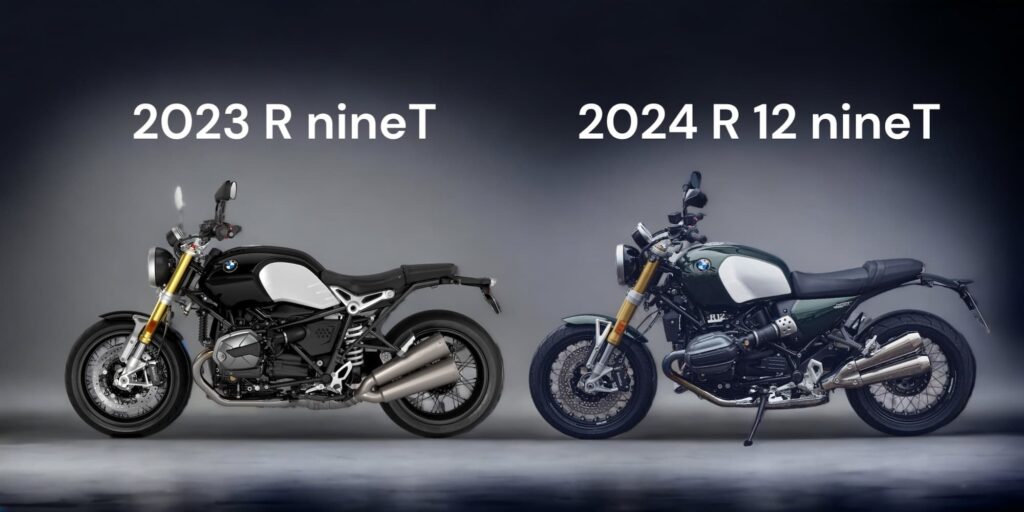
So no, the 2024 BMW R 12 and R 12 nineT are not exactly the same as the outgoing R nineT. They share an engine. It’s the same engine physically, with the same dimensions, and in the same state of tune in the R 12 nineT, but with reduced peak power int he R 12 cruiser.
But there are some other fundamental differences between the R nineT and the R 12 models.
Firstly, the BMW R 12 / R 12 nineT’s frame is an all-new one-piece trellis bridge steel frame with a bolt-on subframe. It’s designed to allow more customizability. The airbox is under the seat, which means there’s more versatility in tank shapes for enthusiastic customisers.
BMW also repositioned the rear strut on the R 12 models vs the R nineT. The drive is still a BMW Paralever Evo shaft, but BMW angled the strut forward to allow for more space on top. (The strut is essentially vertical on the old R nineT). BMW also added a hydraulic final stop to prevent hard bottoming out.
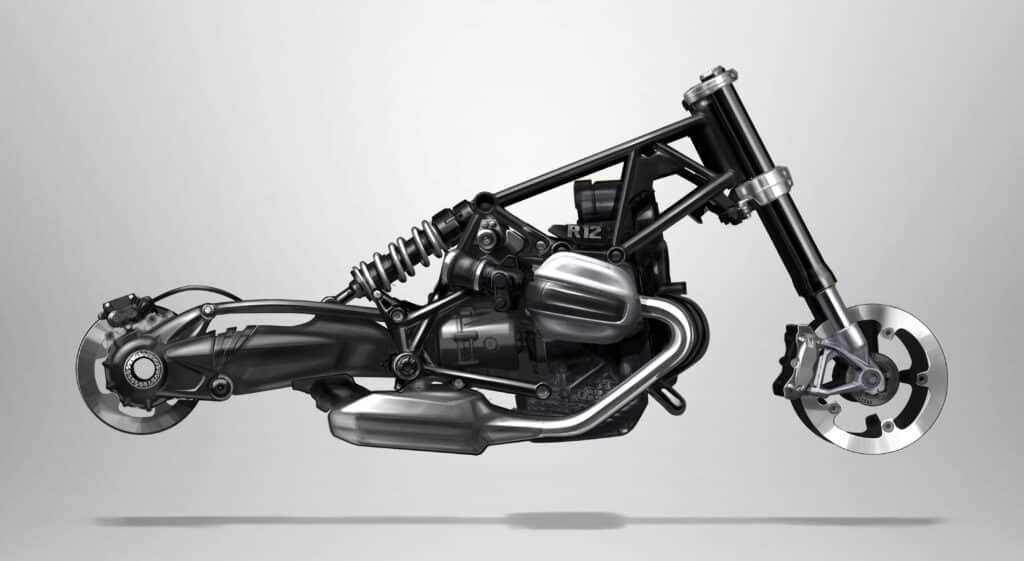
The instruments of the R 12 vehicles are a bit different. They’re larger. The R 12 nineT has twin gauges, like the outgoing R nineT (top-spec model), but the R 12 cruiser has just a single gauge standard. Both come with a USB-C port and a 12V socket.
You can also get an optional thin 3.5-inch display for both.
In terms of tech level, BMW added keyless ride as standard for both vehicles. But you still need a key for the fuel tank cap.
The R 12 models get an optional quick shifter (Shift Assistant Pro). This was technically possible with the ride-by-wire on the R nineT, but BMW never provided the option.
And cruise control and heated grips are no longer standard on the R 12 models. They’re in the “Comfort package”, which also gets you a quick shifter and hill start control. This is a bit of a bummer, though I’m sure the Comfort package will almost always be chosen.
Aside from those differences, there’s the R 12 model, which is quite different in that it’s a cruiser. Below I’ll look at how the R 12 is different from the R 12 nineT.
Common Specs of the BMW R 12 and BMW R 12 nineT
Below are the common specs between the BMW R 12 and R nineT, just to highlight the parts that are the same.
Below, we’ll look at what is different between the BMW R 12 and R 12 nineT
| Item | Spec | Notes |
|---|---|---|
| Engine | 1170 cc air/oil-cooled boxer, “Twin Cam” motor Some power differences — see below | Same basic engine as the R nineT. |
| Front suspension | Upside-down telescopic fork (adjustability varies) | Only the top-spec R nineT had a USD. |
| Rear suspension | Telelever, monoshock. Adjustable preload and rebound damping. Hydraulic final stop. | Similar to the R nineT |
| Front brakes | 2 x 310 mm discs, radially mounted 4-piston monoblock calipers | Same as the R nineT |
| Instruments | Round gauges standard, optional TFT (see below) | Same as the R nineT. Only top spec had twin gauges. |
| Ride aids | DTC, keyless ride, IMU / cornering ABS, optional cruise control, optional quickshifter | Some differences of standard spec level from the R nineT |
BMW R 12 and BMW R 12 nineT differences
Now, let’s look at how the BMW R 12 nineT (roadster) and the BMW R 12 (cruiser) differ.
| Item | R 12 nineT | R 12 |
|---|---|---|
| Peak power | 80 kW / 109 hp @ 7000 rpm | 70 kW / 95 hp @ 6500 rpm |
| Peak torque | 115 Nm / 85 lb-ft @ 6500 rpm | 110 Nm / 81 lb-ft @ 6000 rpm |
| Intent | Roadster | Cruiser |
| Tank | Aluminium with brushed / clear-coated panels | Steel, “Toaster tank” of BMW /5 models |
| Front suspension | Fully adjustable USD | USD, non-adjustable |
| Front/rear wheel size | 17/17 | 19/16 |
| Rake | 27.7 degrees | 29.3 degrees |
| Trail | 4.4 inches | 5.2 inches |
| Front / rear suspension travel | 120 mm / 4.7 inches | 90 mm / 3.5 inches |
| Ride modes | 3 – Rain, Road, Dynamic | 2 – Rock, Roll |
| Instruments | Twin gauges, optional 3.5-inch TFT | Single speedometer, optional tachometer. Optional 3.5-inch TFT |
| Colours (at launch) | 1. Blackstorm metallic 2. San Remo Green metallic Option 719 “Aluminium” brushed / Night black | 1. Blackstorm metallic 2. Aventurine Red metallic 3. Option 719 “Thorium” in Avus Silver metallic |
The riding position says a lot. Look at the BMW R 12 nineT’s sporty riding position. Note in particular the knee bend and the angle forward over the bars.
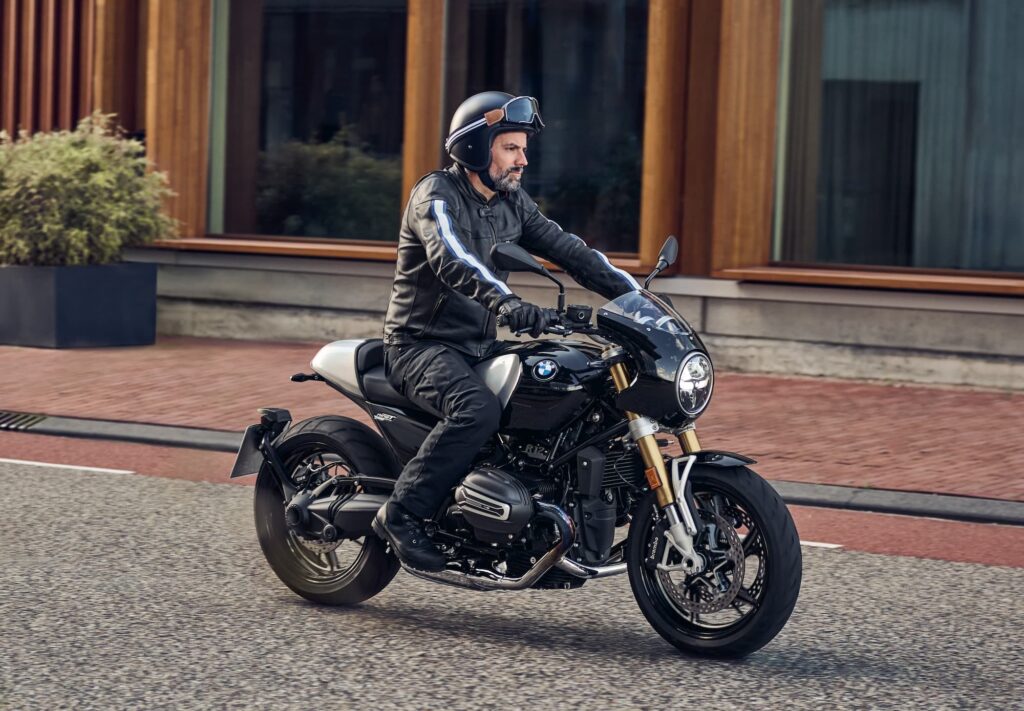
And now look at the comfortable riding position of the R 12.
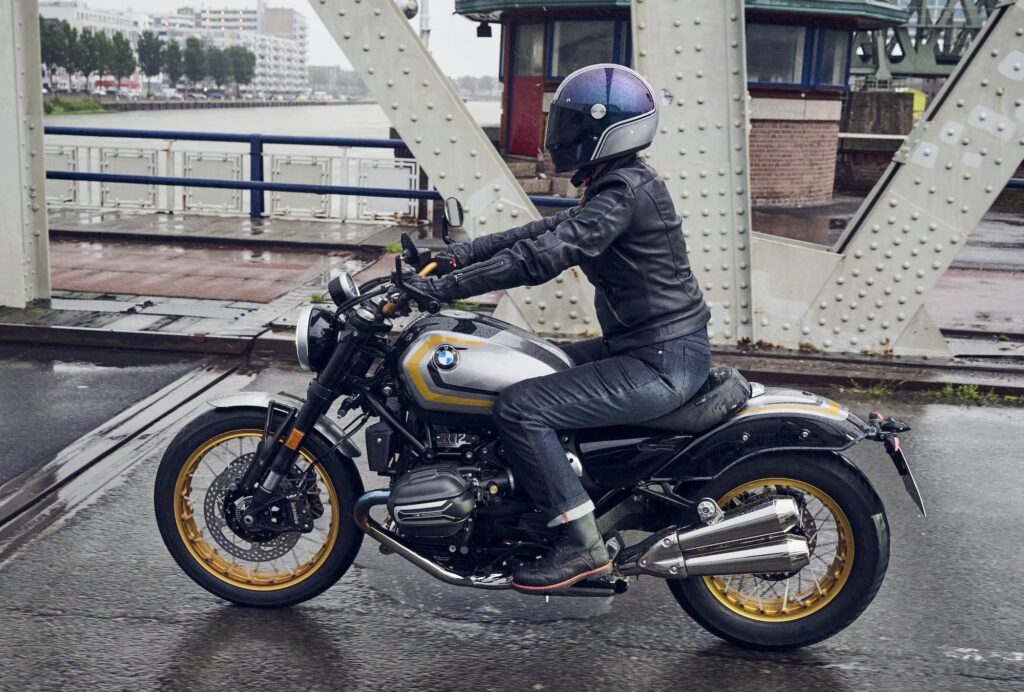
On the R 12, the rider is much more upright, and the legs are much more relaxed. They’ll scrape more quickly, too, mind you.
The riding position is almost the driving force of the rest of the changes, though there are a few others that are interesting.
One interesting difference to note is that the engine in the R 12 is tuned for less peak power, but not for the benefit of more low-end torque.
In fact, here’s the torque curve that BMW provided. Perplexing. Why can’t we just have it all?
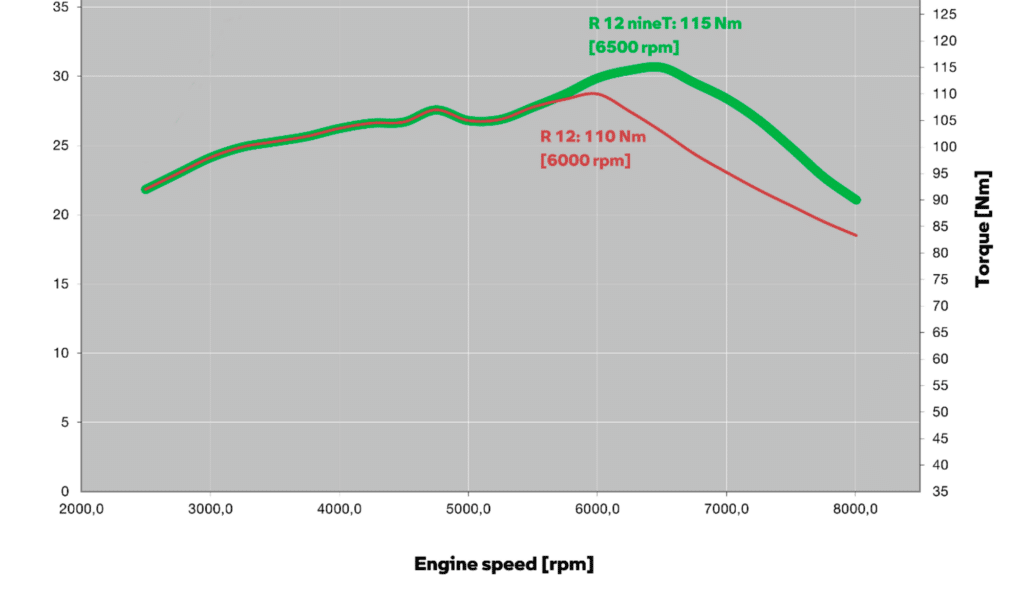
The only reason I can think of for limiting peak power of the R 12 to 95 hp would be so that you can legally create an A2 license version in jurisdictions where the law is that 35 kW / 47 hp is the legal limit, and it can’t be less than half the original power. That must be it.
I suppose the R 12 is more beginner-friendly than the R 12 nineT, with its lower seat height and easier riding position, too.
Similarly, the R 12 has different ride modes from the R 12 nineT. The R 12 has “Roll” (modest) and “Rock” (aggressive) ride modes, similar to the R 18. The R 12 nineT has similar ride modes to the R nineT of “Rain”, “Road”, and “Sport”.
Finally, the different riding positions and power outputs also have led BMW’s tech team to give the two models different suspension specs. The R 12 nineT has a fully adjustable fork, whereas the R 12 cruiser does not. Further, the R 12 nineT has more aggressive rake and shorter trail, for sharper steering, compared to the cruiser. Finally, the BMW R 12 nineT also has more suspension travel, which will mean slightly more ride height (less novice-friendly), and better ground clearance.
Wrap up
I must say I’m a bit surprised BMW is closing out all the model variants of the R nineT just like that. I thought that the R 12 would be an addition, not a replacement.
No more Pure? No more Scrambler or Urban G/S? What a shame. I think some of those — particularly the Urban G/S — are likely to become low-key collector items, as they become more rare in particular. If you’re after an R nineT, this may be one of your last chances to get one.
I’m also surprised that a few things I thought were really nice on the R nineT — standard cruise control — have been phased out. There’s no reason why other than to provide an excuse to charge for more add-ons.
Anyway, the popularity of the R nineT line suggests that maybe there’ll be more R 12 variants in the future. We’ll wait and see.

